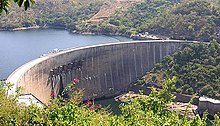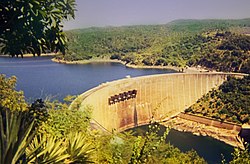Kariba Dam
| Kariba Dam | |
|---|---|
 | |
| Construction cost | US$480 million |
The Kariba Dam is a hydroelectric dam in the Kariba Gorge of the Zambezi river basin between Zambia and Zimbabwe. It is one of the largest dams in the world, standing 128 m (420 ft) tall and 579 m (1,900 ft) long.[1]
Construction
The double curvature concrete arch dam was constructed between 1955 and 1959 by Impresit of Italy[2] at a cost of $135,000,000 for the first stage with only the Kariba South power cavern. Final construction and the addition of the Kariba North Power cavern by Mitchell Construction[3] was not completed until 1977 due to largely political problems for a total cost of $480,000,000. 86 men lost their lives during construction.[2]. It has really helped Zambia.
Power generation
The Kariba Dam supplies 1,266 MW of electricity to parts of both Zambia (the Copperbelt) and Zimbabwe and generates 6,400 GW·h (23 PJ) per annum. Each country has its own power station on the north and south bank of the dam respectively. The south station belonging to Zimbabwe has been in operation since 1960 and has six generators of 117.5 MW capacity each.[4] The north station belonging to Zambia has been in operation since 1976, and has four generators of 153.5 MW each for a total of 615 MW; work to expand this capacity to 1,080 MW is expecting completion in December 2012.[5] Lake Kariba, the reservoir created by the dam, extends for 280 km (174 mi) with a storage capacity of 180 km³.
Choice of location
The Kariba Dam project was proposed and implemented by the government of the Federation of Rhodesia and Nyasaland, or Central African Federation (CAF). The CAF was a semi-independent state in southern Africa that existed from 1953 to the end of 1963, comprising the former self-governing Dominion of Southern Rhodesia and the British Colonies of Northern Rhodesia and Nyasaland. Northern Rhodesia had decided earlier in 1953 (before the Federation was founded) to build a dam within its territory, on the Kafue River, a major tributary of the Zambezi. It would have been closer to Zambia's Copperbelt which was in need of more power. This would have been a cheaper and less grandiose project, with a smaller environmental impact.Southern Rhodesia, the richest of the three, objected to a Kafue dam and insisted that the dam be sited instead at Kariba. Also, the capacity of the Kafue dam was much lower than Kariba.[6] The Zambezi river is the boundary between the two Rhodesias, and so the dam itself and the lake it formed both straddle the boundary. It was hoped that this fact would help to cement the CAF; but the growing clamour for independence led to the breakup of the Federation in 1963. The Kariba Dam is now jointly owned and jointly operated by Zimbabwe and Zambia.
Since Zambia's independence, two dams have been built on the Kafue River: the Kafue Gorge Dam and the Itezhi-Tezhi Dam.
Environmental impacts
Population displacement and resettlement
Several thousand large animals threatened by the rising water were rescued by Operation Noah.
The creation of the reservoir forced resettlement of about 57,000 Tonga people living along the Zambezi in both Zambia and Zimbabwe. The Tonga were one of the more primitive tribes in the region, and had had little contact with Europeans.
It is important to remember Southern Rhodesia was a self-governing Dominion and the government could effectively command that the people be removed, similar to "compulsory purchase" in Britain, whereas Northern Rhodesia was a colony, and governed by consent after consultation with the tribal chiefs.
The Tonga people were forced to leave their homes and fertile lands that had been under cultivation for hundreds of years, although their farming was of the "slash-and-burn" method whereby the villages were abandoned after a few years when the soil became less fertile, the villagers moving to a new patch of bush and building a new village, see "The Shadow of The Dam" mentioned below. The reservoir flooded the land where for centuries these people had farmed, fished, worshipped, raised their children and buried their dead.
Both the Southern Rhodesian and the Northern Rhodesian Governments provided aid to the displaced people, and built them new permanent villages. In Southern Rhodesia, the villagers were told when lorries would be coming to fetch them. Troops were on hand to help, and to ensure there was no trouble. The moves went relatively well. Branches were dragged behind the lorries to draw the spirits of the ancestors to the new villages.
Unfortunately, in Northern Rhodesia the local people believed outside trouble-makers, who assured them that they could refuse to move. They also could not believe that the river could be tamed. The Government tried and tried to persuade them to move, including even a visit by the Governor himself, which was a disaster. Ultimately, this process resulted in the moves taking place six months later than they should have done, with the result that it was too late to plant crops.
From "The Shadow of The Dam", a first-hand account written by David Howarth in the 1960s, referring to the situation in Northern Rhodesia:- "Everything that a government can do on a meagre budget is being done. Demonstration gardens have been planted, to try to teach the Tonga more sensible methods of agriculture, and to try to find cash crops which they can grow. The hilly land has been plowed in ridge contours to guard against erosion. In Sinazongwe, an irrigated garden has grown a prodigious crop of pawpaws, bananas, oranges, lemons, and vegetables, and shown that the remains of the valley could be made prolific if only money could be found for irrigation. Cooperative markets have been organized, and Tonga are being taught to run them. Enterprising Tonga have been given loans to set themselves up as farmers. More schools have been built than the Tonga ever had before, and most of the Tonga are now within reach of dispensaries and hospitals."[7]
There are many different perspectives on how much resettlement aid was given to the displaced tribe. According to anthropologist Thayer Scudder, who has studied these communities since the late 1950s, "Today, most are still 'development refugees.' Many live in less-productive, problem-prone areas, some of which have been so seriously degraded within the last generation that they resemble lands on the edge of the Sahara Desert."[8] To some extent this may be because the villagers were re-settled into permanent villages, where slash-and-burn agriculture was no longer appropriate, but they had no concept or tradition of fertilising the ground.
Independence came to Northern Rhodesia in 1964. To the new Government, the primitive people in the Zambesi Valley were of little importance.
A 2005 book, "Deep Water" by Jacques Leslie focused on the plight of the people resettled by the dam, and found the situation little changed. Kariba remains the worst dam-resettlement disaster in African history.[9]
Basilwizi Trust

In a quest to restore their lives and find justice, the Tonga formed their own advocacy group in 2000, the Basilwizi Trust.[10] Basilwizi sees itself as a culmination of numerous efforts by the affected people to be heard by the government authorities. They are working to define their needs, and to help the whole community gain skills to directly lobby decision-makers.
In 2005, Basilwizi conducted extensive research on the socio-economic status of the Tonga people. Their report states: "The Gwembe Tonga on the Zambian side and the Zimbabwean Tonga are one; but due to separation brought about by the dam, they are now considered different people. Their languages have become slightly different over the years. Some, especially on the Zimbabwean side, no longer speak Tonga, the language of their ancestors, due to dominance of other indigenous languages." Basilwizi is now undertaking new activities to revive the Tonga culture, to preserve the language and to build local access to education. They are also focusing on food security and access to electricity, still lacking after 50 years.
The group is also calling on the World Bank and other parties involved in building the dam to bring justice to the Tonga. "Calls for reparation, coming many years after the displacement of these people from the land of their ancestors, have not yielded any significant benefits," observes Basilwizi in its recent report. "Such compensation could be in monetary terms, decommissioning of the dam, official recognition of past and current injustices suffered, or complete restoration of the ecosystems. A new dialog to correct the wrongs committed should commence. The Tonga are … trying to find solutions to their predicament and to rise out of the imposed poverty. The perpetrators should not look at this as a social obligation but a realization that this could have been done better and so what economic, political and cultural program can follow."
River ecology
The Kariba Dam controls 40% of the total runoff of the Zambezi River, thus changing the downstream ecology dramatically.
Wildlife rescue
From 1960 to 1961, 'Operation Noah' captured and removed around 6,000 large animals and numerous small ones threatened by the lake's rising waters.
Recent activity
On the 6th of February 2008, the BBC reported that heavy rain might lead to a release of water from the dam, which would force 50,000 people downstream to evacuate.[11] Rising levels led to the opening of the floodgates in March 2010, requiring the evacuation of 130,000 people who lived in the floodplain, and causing concerns that flooding may spread to nearby areas.[12]
Etymology
The name Kariba is thought to be a corruption of the Shona word for a trap. Kariva is a little trap and it is believed when those who wished to construct the dam wall wanted to explain the nature of the project to the locals they emphasised that they wanted to build a little water trap-Kariva. However, the complex pronunciation of the 'v' in Kariva saw the Western constructors produce a sound much like a 'b' hence the creation of the word Kariba.
See also
References
- ^ "Kariba Dam". Columbia Encyclopedia, 6th Ed. Retrieved 2007-07-31.
- ^ a b Spurwing facts
- ^ Indictment: Power & Politics in the Construction Industry, David Morrell, Faber & Faber, 1987, ISBN 978-0-571-14985-8
- ^ "Kariba Dam, Zambia and Zimbabwe; Final Report: November 2000" (PDF). World Commission on Dams. 2000. p. VI. Retrieved 2010-11-17.
- ^ "DBSA provides $105m for Zambia hydropower expansion". Cramer Media's Engineering News. 2010-11-05. Retrieved 2010-11-17.
- ^ "Kariba Dam, Zambia and Zimbabwe; Final Report: November 2000" (PDF). World Commission on Dams. 2000. p. 9. Retrieved 2010-11-17.
- ^ Howarth, David, The shadow of the dam, Collins, 1961
- ^ "Pipe Dreams: Can the Zambezi River supply the region's water needs?". Cultural Survival Quarterly. Retrieved 2007-07-31.
- ^ "When Elephants Fight". Columbia Journalism Review. Archived from the original on 2007-09-30. Retrieved 2007-07-31.
- ^ "Basilwizi: Promoting Development in the Zambezi Valley". Basilwizi. Retrieved 2007-07-31.
- ^ Floodgates to open in Mozambique
- ^ Zambia opens dam to alleviate flooding


